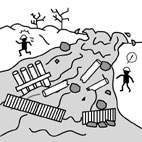| Case Name |
The debris flow of the Kanbarasawa |
| Pictograph |

|
| Date |
December 6, 1996 |
| Place |
Otani village, Kitaazumi district, Nagano prefecture |
| Location |
Construction fields such as disaster related project |
| Overview |
The destruction near a 1300m altitude became a trigger, and the large-scale debris flow arose. The debris flow flowed over 5 waves (8 waves (small waves are included)). one of two valley closing constructions which did not have deposited silt right after the concrete cast was completely destroyed and the other was half destroyed by the first wave which was the biggest. After the debris flow passed the two checkdams downstream with no deposited silt, the checkdam under construction and the watercourse construction, it reached the Himekawa river. This debris flow hit the construction sites of disaster related project etc, which Ministry of Construction ( now Ministry of Land, Infrastructure and Transport ), Forestry Agency and Nagano Prefecture ordered. |
| Incident |
The debris flow arose from the landslide on the right side slope near the 1300m altitude. The 39000m3 of gravel which was destroyed in the upper section destroyed valley closing constructions of afforestation (1 was completely destroyed, 1 was half destroyed) and it got over 2 checkdams, and it became the debris flow which were over 5 waves (or 8 waves (when small waves are included), and attacked the lower section. |
| Sequence |
The 35cm snow depth was recorded from December first to second, and the precipitation was 32mm. The cyclone passed on December fifth which was the previous day when the debris flow generated, and the precipitation was 49mm. Then, the precipitation was not recorded from December fifth, 21 o'clock, to the time the debris flow generated. Because of the passage of the cyclone, the temperature increased about 10°C, and the snow depth lowered from 18cm to 6cm from December fifth to sixth during which temperature exceeded 0°C. It was 109mm of 24 hour amount of rainfall when the snowmelt quantity was calculated. This is not an unusual amount of rainfall especially . |
| Cause |
The primary causes which led to the debris flow are divided into landform condition and geotechnical condition. As a landform condition, the reason was "the extension destruction" of the slope which became unstable because of the destruction which arose on July 11th, 1995, and that the landslide was the erosion front, the steep slope. As a geotechnical condition, it is said to be a boundary between the weak nature of andesite lava and the strong sandstone bed. |
| Response |
The Self-Defense Forces was urgently dispatched. The field disaster countermeasure headquarters was founded, and the search for the missing persons was undertaken by 1600 people. |
| Countermeasures |
The first, grasping the watershed situation and informing the construction party. The socond, the development of forecast and detection technique of the debris flow. The third, the ideal method of caution and refuge system. |
| Knowledge Comment |
The standard for caution and refuge is established in proportion to the division in the construction field with the possibility of which a natural disaster might arise. |
| Background |
On July 11th,1995, landslides etc were caused by local heavy rainfall, and over 3000 people took refuge. And, on July 25th, 1996, because of heavy rainfall, the gravel near the prefectual road was destroyed and closed the bridge. The construction of the checkdam was started, since there was the fear that the debris flow might occur afterwards. The debris flow attacked the construction field which was to be completed in January, the following year. |
| Scenario |
| Primary Scenario
|
Poor Value Perception, Poor Safety Awareness, Carelessness, Insufficient Precaution, Insufficient Analysis or Research, Insufficient Environment Study, Planning and Design, Poor Planning, Failure, Fracture/Damage, Failure, Fracture/Damage, Bodily Harm, Death, Bodily Harm, Injury
|
|
| Sources |
12.6 The report of disaster of debris flow in Kanbarasawa( the corporation aggregate: Erosion -Control Engineering Society)
|
| Number of Deaths |
14 |
| Number of Injuries |
9 |
| Multimedia Files |
Fig2.Quotation from Ministry of Land, Infrastructure and Transport Matsumoto preventing sand erosion office HP
|
| Field |
Civil Engineering
|
| Author |
KUNISHIMA, Masahiko (The University of Tokyo)
HASEGAWA, Tomoaki (The University of Tokyo)
|
|